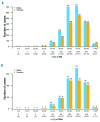Outcome and survival of myeloma patients diagnosed 2008-2015. Real-world data on 4904 patients from the Swedish Myeloma Registry
- PMID: 29217784
- PMCID: PMC5830385
- DOI: 10.3324/haematol.2017.178103
Outcome and survival of myeloma patients diagnosed 2008-2015. Real-world data on 4904 patients from the Swedish Myeloma Registry
Abstract
Epidemiology and outcome of myeloma are mainly reported from large university centers and collaborative groups, and do not represent 'real-world' patients. The Swedish Myeloma Registry is a prospective population-based registry documenting characteristics, treatment and outcome in newly diagnosed myeloma, including asymptomatic and localized forms, with the purpose of improving disease management and outcome. This report presents information on patients diagnosed between 2008 and 2015, including data on first-line treatment in patients diagnosed up to 2014, with a follow up until December 2016. We present age-adjusted incidence, patients' characteristics at baseline, treatment, response, and survival. Baseline data were available with a 97% coverage in 4904 patients (median age 71 years, males 70 years, females 73 years; 72% were 65 years or older), and at 1-year follow up in 3558 patients with symptomatic disease (92% of patients initially reported). The age-adjusted incidence was 6.8 myeloma cases per 100,000 inhabitants per year. Among initially symptomatic patients (n=3988), 77% had osteolytic lesions or compression fractures, 49% had anemia, 18% impaired kidney function, and 13% hypercalcemia. High-dose therapy with autologous stem cell transplantation was given to 77% of patients aged up to 66 years, and to 22% of patients aged 66-70 years. In the study period, 68% received bortezomib, thalidomide, and/or lenalidomide as part of the first-line treatment, rising from 31% in 2008 to 81% in 2014. In active myeloma, the median relative survival of patients aged 65 years or under was 7.7 years, and 3.4 years in patients aged 66 years and over. Patients diagnosed with myeloma in more recent years were associated with significantly higher rates of complete or very good partial remission (P<0.05), and with a significantly higher survival, with a Hazard Ratio (HR) of 0.84 (95%CI: 0.77-0.92; P<0.05). There was a small, but significant survival benefit in patients treated at university hospitals (HR 0.93; 95%CI: 0.87-0.99; P<0.05). We report here on a near complete 'real-world' population of myeloma patients during an 8-year period; a period in which newer drugs were implemented into standard practice. The overall incidence and median age were both higher than in most previous studies, indicating a more complete coverage of older patients. Myeloma survival in Sweden is comparable to other large registry studies, and responses and survival improved during the study period.
Copyright© 2018 Ferrata Storti Foundation.
Figures



References
-
- Bird J, Behrens J, Westin J, et al. UK Myeloma Forum (UKMF) and Nordic Myeloma Study Group (NMSG): guidelines for the investigation of newly detected M-proteins and the management of monoclonal gammopathy of undetermined significance (MGUS). Br J Haematol. 2009;147(1):22–42. - PubMed
-
- Rajkumar SV. Multiple myeloma: 2013 update on diagnosis, risk-stratification, and management. Am J Hematol. 2013;88(3):226–235. - PubMed
-
- Kristinsson SY, Anderson WF, Landgren O. Improved long-term survival in multiple myeloma up to the age of 80 years. Leukemia. 2014;28(6):1346–1348. - PubMed
-
- Gay F, Larocca A, Wijermans P, et al. Complete response correlates with long-term progression-free and overall survival in elderly myeloma treated with novel agents: analysis of 1175 patients. Blood. 2011;117(11):3025–3031. - PubMed
-
- San Miguel JF, Schlag R, Khuageva NK, et al. Bortezomib plus melphalan and prednisone for initial treatment of multiple myeloma. N Engl J Med. 2008;359(9):906–917. - PubMed
MeSH terms
LinkOut - more resources
Full Text Sources
Other Literature Sources
Medical

